gauli glacier

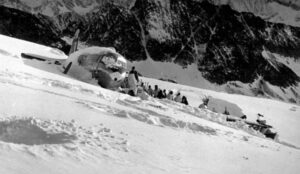 When Switzerland found itself in the middle of an unusual heatwave, the Gauli Glacier melted enough to uncover the wreckage debris of an American World War II plane that crash-landed in the Bernese Alps 72 years ago. Now, when you hear about the crash of a plane, especially into a mountain or in this case, a glacier, you expect to find fatalities. Of course, this plane crashed a long time ago, and the authorities already knew the outcome of that crash. The people who found the plane in the ice, however, might not have. This plane, a C-53 Skytrooper Dakota had been traveling from Austria to Italy when it collided with the Gauli Glacier at an altitude of 10,990 feet on that fateful day.
When Switzerland found itself in the middle of an unusual heatwave, the Gauli Glacier melted enough to uncover the wreckage debris of an American World War II plane that crash-landed in the Bernese Alps 72 years ago. Now, when you hear about the crash of a plane, especially into a mountain or in this case, a glacier, you expect to find fatalities. Of course, this plane crashed a long time ago, and the authorities already knew the outcome of that crash. The people who found the plane in the ice, however, might not have. This plane, a C-53 Skytrooper Dakota had been traveling from Austria to Italy when it collided with the Gauli Glacier at an altitude of 10,990 feet on that fateful day.
It was November 19, 1946, and the plane carrying four crew members and eight passengers were enjoying their trip, when something went terribly wrong. When they hit the glacier, several people were injured, amazingly, there were no fatalities. Among the passengers were high-ranking United States service members traveling with relatives…four women and one 11-year-old girl. Now, they found themselves high up on a glacier, and it was likely very cold. They were stuck at the crash site for six days before rescuers found them and could 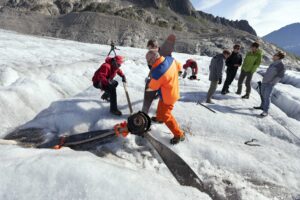
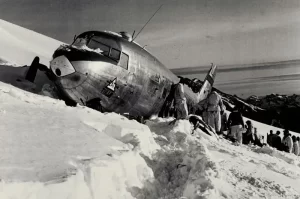 get to them. They were forced to drink snow water and ration chocolate bars to survive, but survive they did. Many times, survival at a crash site, if you survived the initial crash, is all about using common sense and keeping your wits about you. You have to take stock of your supplies and be willing to ration what you have. You can’t let anyone get out of control, because a panic could waste vital supplies. Water is the most vital of the supplies, because while the human body can go weeks without food, it can only live a few days without water. While it would seem that water on a glacier would be plentiful, it may not be so. You would have to chip away at the ice, and then melt it to drink. In addition, you have to get it warm, or you will risk the water causing Hypothermia. This particular group managed to do things right, or at least enough right to survive the six days while they waited for rescue. Once rescued, they went on with their lives feeling very blessed to be alive.
get to them. They were forced to drink snow water and ration chocolate bars to survive, but survive they did. Many times, survival at a crash site, if you survived the initial crash, is all about using common sense and keeping your wits about you. You have to take stock of your supplies and be willing to ration what you have. You can’t let anyone get out of control, because a panic could waste vital supplies. Water is the most vital of the supplies, because while the human body can go weeks without food, it can only live a few days without water. While it would seem that water on a glacier would be plentiful, it may not be so. You would have to chip away at the ice, and then melt it to drink. In addition, you have to get it warm, or you will risk the water causing Hypothermia. This particular group managed to do things right, or at least enough right to survive the six days while they waited for rescue. Once rescued, they went on with their lives feeling very blessed to be alive.
The snow, and later, ice covered the plane as the years went by, and it was very likely forgotten…until 2012 anyway, when three young people discovered the plane’s propeller on the glacier. They continued to observe the emerging plane and as the glacier continued to melt, the scene unfolded. Today, it reportedly looks like a 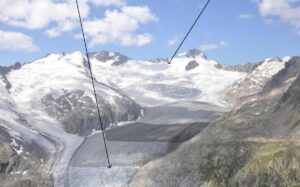
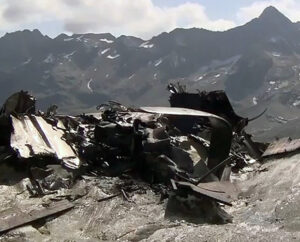 field covered in plane debris, and many people probably wonder how anyone managed to live through the initial crash…much less everyone. As the glacier melted, the plane slid down the mountainside and was expected to finally emerge at the bottom. In fact, much of the debris field might actually be caused by the melting ice.
field covered in plane debris, and many people probably wonder how anyone managed to live through the initial crash…much less everyone. As the glacier melted, the plane slid down the mountainside and was expected to finally emerge at the bottom. In fact, much of the debris field might actually be caused by the melting ice.
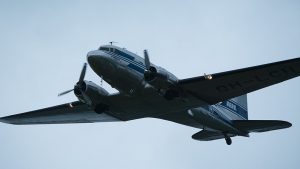 Storms and high winds are not unusual in the Swiss Alps, and flying over any mountain can find a flight crew in hot water. Over the Swiss Alps, on November 18, 1946, the crew of the C-53 Skytrooper with serial 42-68846 that had taken off from Tulln Air Base near Vienna, Austria, was bound for Pisa in Northern Italy, when they encountered problems. The flight took them over Innsbruck in the Western Austrian Alps. While flying over the Canton of Bern, Switzerland, the weather had unknowingly caused them to lose their bearings. Their actual flight path was taking them deeper South, into the Alps of Central Switzerland.
Storms and high winds are not unusual in the Swiss Alps, and flying over any mountain can find a flight crew in hot water. Over the Swiss Alps, on November 18, 1946, the crew of the C-53 Skytrooper with serial 42-68846 that had taken off from Tulln Air Base near Vienna, Austria, was bound for Pisa in Northern Italy, when they encountered problems. The flight took them over Innsbruck in the Western Austrian Alps. While flying over the Canton of Bern, Switzerland, the weather had unknowingly caused them to lose their bearings. Their actual flight path was taking them deeper South, into the Alps of Central Switzerland.
As often occurs in high mountains, the aircraft encountered a violent downdraft, known as a katabatic wind at a speed of 170 miles per hour. The katabatic wind is comparable to a microburst that basically pushes even big jets into the ground on approach flights. The downdraft caused the aircraft to lose height rapidly in poor visibility conditions. There was no time to recover, and at 2:45pm, the plane hit terrain and crash-landed into the Gauli Glacier at an altitude of 10,990 feet. They had gone down just about 8 miles south of the Swiss Air Force Base Meiringen.
The crash had the potential of being a deadly situation. Crashing a plane into terrain…especially at a high altitude is not usually survivable, but this was a God Gift. The crash occurred on snow-covered near-flat terrain with a slightly sloping hill. For the passengers and crew in the aircraft to step out alive…that was the God Gift. Very few people have crashed into terrain and lived tell the story afterwards! The crew was able to send a distress call from the stricken plane that was picked up in Paris and Lyon, but they erroneously presumed that the crash had occurred in the French Alps. Two days later, an officer based in the control tower of the Meiringen airbase, received a message on his frequency as well and gave the alert of a new radio bearing, narrowing the search area to the Gauli Glacier. That’s two days in freezing November nights at 10,990 feet, with only the fuselage to protect them from the elements. There were two sightings during breaks in the clouds, and finally a rescue team made their way up to bring the crew and passengers down. Twelve people survived the crash and lived to tell about it.
After the rescue, the plane sat there in the glacier until the summer of 1947, when the dismantling of the 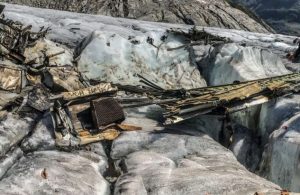 aircraft started. The most precious parts like engines, and (cockpit) interior were airlifted from the scene. The bend propellers were left behind and the partially empty but intact airframe was left behind on the Glacier, where the ice would slowly grind it to pieces. In 2012, pieces of the C-53 began to appear as the glacier melted in the sunlight. Amazingly, there were no traces of corrosion. While the ice has made its mark on the plane’s structure, rendering it to a state that only remotely resembles the plane, it is still there. It now looks like the plane was torn apart in the crash. Of course, we know that was not the case at all.
aircraft started. The most precious parts like engines, and (cockpit) interior were airlifted from the scene. The bend propellers were left behind and the partially empty but intact airframe was left behind on the Glacier, where the ice would slowly grind it to pieces. In 2012, pieces of the C-53 began to appear as the glacier melted in the sunlight. Amazingly, there were no traces of corrosion. While the ice has made its mark on the plane’s structure, rendering it to a state that only remotely resembles the plane, it is still there. It now looks like the plane was torn apart in the crash. Of course, we know that was not the case at all.

